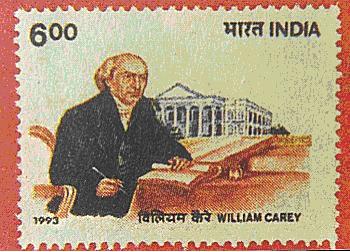William Carey
We continue our series on the Pioneers of Indology by remembering William Carey who inspired millions of poor citizens of India to lead a purposeful life. William Carey was born in Paulerspury village in England on January 17th, 1761. His cobbler father found it extremely difficult to make both ends meet, with six children to look after. Hence he could not afford to provide any of his children with a formal education. At the age of ten, Carey was taken up with fascinating stories of far-away countries and made a promise to himself to someday visit India. As a young man, he had great confidence in himself and in God and became a missionary.
William Carey
(1761-1834)
After a five-month long sea voyage, he landed at Kolkata (a.k.a. Calcutta) on January 9th, 1793. He was accompanied by his wife Dorothy and four children. During his journey Carey kept himself busy in the study of Bengali. Upon arrival he rented a house in Kolkata, and then later moved to the Sunderban area, finally settling in Shrirampur (in the present day state of West Bengal). He worked with a missionary zeal and attracted like-minded people to his camp. The community first started a school for boys and later added a school for girls.
During the Moghul rule of India, the Persian language was strongly encouraged, to the detriment of Sanskrit and other indigenous languages. Carey was instrumental in the revival of these languages. In collaboration with Raja Ram Mohan Roy he published pamphlets and articles denouncing social evils. He educated people about the problems associated with child-marriage, the neglect of female infants and the Sati system. This led Lord Bentick, the Governor General of India, to ban the practice of Sati in 1829 (see The Sati Practice - The Timeline).
Carey bought a printing press from his personal funds and undertook the printing of books. His team produced numerous manuscripts and translations, which were printed on this press. The types for the press were formulated and manufactured at Shrirampur and printing began in various Indian languages. After twelve years of research, Carey's team produced such high quality paper that it was insect-proof, long-lasting and ideally suited to Indian conditions. The team received printing orders from far and near. Even the Maharaja of Mysore (a kingdom far to the south) had some important books printed at the Shrirampur press. Unfortunately, however, in 1812 a huge fire broke out in the press, in which most of the paper stored for printing was reduced to ashes, along with Carey's writings of ten long years. His year-long work on the translation of the "Ramayana" into English was also lost. Undaunted by this setback, he began the translation work all over again.
A cobbler's son by birth, Carey rose by sheer dint of effort to great heights: he was appointed to teach Sanskrit, Bengali and Marathi at Fort William College, Kolkata, in 1806. After five years of teaching, he was promoted to be a full-fledged professor and continued to teach there for the next thirty years. He introduced the idea of the "savings bank" to protect local people from the clutches of money-lenders. He campaigned for better facilities for lepers and for the aged. He also introduced the use of the steam engine in India.
Carey lived in India for 41 long years. He loved his adopted homeland so much that he did not return to his own country for a long time. During this period, he rendered yeoman services to India. He produced seven grammar books, four dictionaries, thirteen polyglot vocabularies, translations of the bible in forty Indian languages, 132 books of learning on various subjects such as botany, social-customs and literature. He was fascinated by the power and beauty of Indian classics and felt inspired to translate the Ramayana, the Sankhya (a system of philosophy first propounded by Sage Kapila) and the Itihaasamaala for the benefit of English readers. Carey undertook the publication of periodicals such as the monthly Bengali magazine, "Dig-Darshan," an English monthly called "Friends of India" and "Samachar Darshan" on a regular basis. He founded the "Agricultural and Horticultural Society of India" and completed a survey of agriculture in India.
Dr. William Carey died on June 9th, 1834 while he was still physically and mentally very active. In 1993, the Government of India brought out a postal stamp to commemorate the bicentennial of his landing in India, a fitting memorial to this great scholar and philanthropist.
